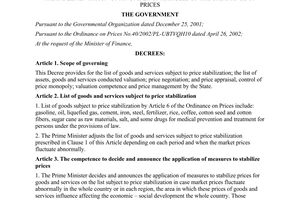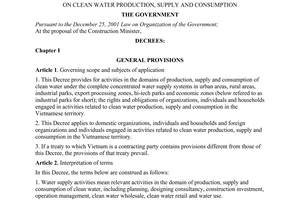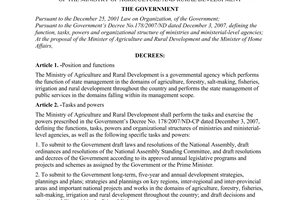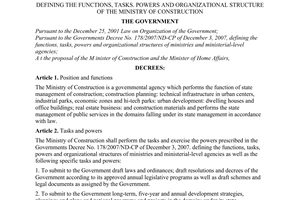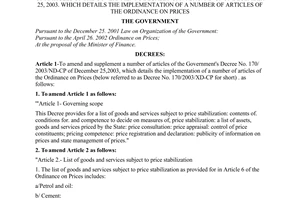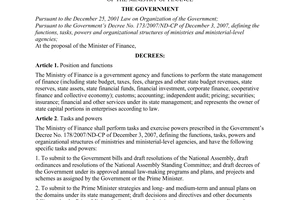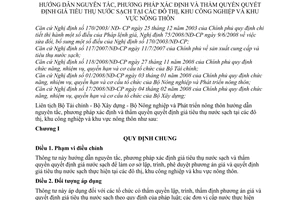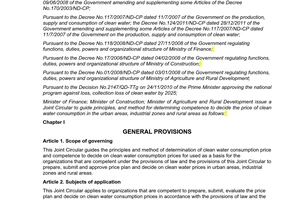Joint cirular No. 95/2009/TTLT-BTC-BXD-BNN guidelines on the principles, methods đã được thay thế bởi Joint circular No. 75/2012/TTLT-BTC-BXD-BNNPTNT guiding principles and method và được áp dụng kể từ ngày 29/06/2012.
Nội dung toàn văn Joint cirular No. 95/2009/TTLT-BTC-BXD-BNN guidelines on the principles, methods
|
THE
MINISTRY OF FINANCE - THE MINISTRY OF CONSTRUCTION - THE MINISTRY OF
AGRICULTURE AND RURAL DEVELOPMENT |
SOCIALIST
REPUBLIC OF VIET NAM |
|
Hanoi, May 19, 2009 |
JOINT CIRCULAR
GUIDELINES ON THE PRINCIPLES, METHODS AND JURISDICTION FOR DETERMINATION OF CLEAN WATER TARIFF RATES AT URBAN AREAS, INDUSTRIAL ZONES AND RURAL AREAS
Pursuant to the Decree No.170/2008/ND-CP dated 25/12/2003 of the Government which stipulates in details on the realization of some articles of the Ordinance on Price, and Decree No.75/2008/ND-CP dated 9/6/2008 on the revisions of some points in the Decree No.170/2003/ND-CP;
Pursuant to the Decree No.117/2007/ND-CP dated 11/7/2007 of the Government on the production, provision and consumption of clean water;
Pursuant to the Decree No.118/2008/ND-CP dated 27/11/2008 of the Government which stipulates the functions, responsibilities, authority and organizational arrangements of MOF;
Pursuant to the Decree No.01/2008/ND-CP dated 03/01/2008 of the Government which stipulates the functions, responsibilities, authority and organizational arrangements of MARD
Pursuant to the Decree No.17/2008/ND-CP dated 04/02/2008 of the Government which stipulates the functions, responsibilities, authority and organizational arrangements of MOC;
Joint Ministries of MOF, MOC and MARD hereby provide guidelines on the principles, methods and jurisdiction to define clean water tariff rates applicable for urban areas, industrial zones and rural areas as follows:
Chapter I
GENERAL REGULATIONS
Article 1. Applicable scope:
This Circular provides guidance on the principles, methods and jurisdiction to define clean water tariff rates in order to make basis for the preparation, submission and approval of water tariff options for urban areas, industrial zones and rural areas.
Article 2. Targeted recipients:
This Circular will target institutions which are authorized for preparation, submission, appraisal of water tariff options and final decision of water tariff rates following the legal regulations; water supplier (provision of retail and wholesale water supply services) and water users.
Chapter II
PRINCIPLES FOR DEFINITION OF CLEAN WATER TARIFF
Article 3. Principles for definition of clean water tariff:
1. Tariff for clean water must be sufficiently, accurately calculated with all appropriate cost elements during the process of production, distribution, consumption following available regulations, standards and technical & economic cost norms approved by functional agencies and appropriate profit rate of merchandized water bulk supplied by organizations, individuals (hereby called water provider) following stipulations in the State’s Regulation on the Price Calculation and guidance from this Circular so that water providers may remain effective operation and development; but it should be suitable with water supply - demand and socio-economic development conditions of the country, region and incomes of local population in each period. Legal rights and benefits of water providers and water-users must be secured; and it should encourage water providers to improve the quality of water & services and strive to reduce production costs, losses to meet the customers’ demand, and encourage water savings.
2. Clean water tariff rates of water provider will not discriminate any economic entities, internal or external organizations and individuals, but should be defined for each water purpose e.g. domestic use (with consideration of the pro-poor in ethnic and mountainous areas, maritime regions and islands, boundary areas following State criteria); water supply for administrative agencies, semi-State institutions as well as production, business and service activities, which should be suitable with consumption feature, water source and production conditions of each locality/area.
3. Domestic water tariff should be properly defined with water quality stipulated in the existing technical standards which were approved by functional agencies.
4. The definition of water tariff rates will sufficiently follow State principles, methods and jurisdiction.
Article 4. Principles for water tariff’s adjustment:
When the production costs and cost price undergo possible variations or changes of water treatment technologies, water quality technical standards and related State policies which results in the increase (or decrease) of the cost price from at least 15%, the appropriate adjustment should be considered by functional agencies.
Chapter III
METHOD FOR CALCULATION OF CONSUMED WATER TARIFF
Article 5. Calculation method of overall cost-price for produced water:
The overall cost-price of clean water, which serves as basis for water tariff calculation, must be defined following technical – economic norms for water production approved by functional agencies (average level of all water providers in the province will not be used) and includes following costs:
|
Or. |
Cost |
Code |
|
1 |
Direct material cost |
Cvt |
|
2 |
Direct labor cost |
Cnc |
|
3 |
General production cost |
Csxc |
|
4 |
Cost price (1+2+3) |
CP |
|
5 |
Enterprise management cost |
Cq |
|
6 |
Sale cost |
Cb |
|
|
Total cost-price (4 + 5 + 6) |
GTtb |
1. For clean water in urban areas, industrial zones (including industrial zones, processing zones, high-tech zones, economic zones – abbreviated as IZ)
Details of above costs are defined as follows:
a. Direct material cost includes materials’ expenses and direct elements to make products such as expenses on raw water (in case of purchasing raw water from other sources), electricity, alum, Cl and additives to water treatment.
It is defined by multiplying total materials amount with correlative price, of which:
- Material amount for production of clean water in urban areas & IZs will follow the clean water production technical-economic norms issued by MOC or other functional agencies. For such materials which are not yet announced or issued by functional agencies in the technical-economic norm system, the president of management board or general director, or the manager of water provider will develop cost norms within water tariff options and then submit to PPC for approval;
- Material price is the actual price set by the State or price quotations price/guidelines (for materials set and managed by the State following such types as price registration, price listing, price disclosure) or market price quoted in the seller’s invoice at the calculation time (for materials which are not set in the State list, or in the price quotation/guidelines) plus (+) proper circulation cost (if any).
b. Direct labor cost includes payments to be made to employees directly involved in the production, such as monthly salary, allowances, shift-meals, social & medical insurance, unemployment insurance and member-fee for trade union. Whereas:
- Salary cost is defined by multiplying actual working days in the clean water production technical-economic norms set by MOC or functional agencies with unit price for a working-day (unit price includes basic wage, and allowances set by the State regulations);
- Expense for shift-meals (if any) for employee involved in the production activity as per current regulations;
- Expenses for social & medical insurance, unemployment insurance and member-fee for trade union for employees following existing regulations;
c. General production cost includes indirect production expenses, besides direct material cost and labor cost stipulated in above points (a and b), to be arisen from production units e.g. depreciation and repair of fixed assets; expenses for materials, tools and equipments for the factory; salary, allowances, shift-meals (if any) paid to the factory’ workers; social & medical insurance, unemployment insurance and trade union’s member-fee of workers in the factory; outsourcing and other related costs.
Cost for the depreciation of fixed assets is calculated as follows:
- For fixed assets funded from State budget: the management, use of fixed assets depreciation cost will comply with MOF regulations;
- For fixed assets sourced from ODA funds: the extraction, management and use of fixed assets depreciation cost will follow MOF’s regulations or agreement in the relevant international treaties if there treaties are contrary to MOF’s regulations.
- For fixed assets formulated from loans (except for ODA loans): the extraction of depreciation cost will be calculated based on loan-period of water supply investment project.
đ. Enterprise management cost includes expenses on overall operation & management activities such as depreciation and repair of fixed assets for management board; wage/salary and allowance, shift-meal (if any) for management board and senior officials of different divisions; social & medical insurance, unemployment insurance and member-fee for trade union for management board; office equipment and facilities, tax, fee/charge and other service costs; and other general costs for the enterprise as repayment of loan interest, contingencies, reception, R&D activities, environmental protection, training, medical care for employees, costs for female employees and other related costs following current regulations. Enterprise management cost will be distributed into the cost price following suitable formula/criteria for enterprise’s products e.g. clean water production, construction & installation and other products (if any).
d. Sale cost includes all items of expenditures relating to the consumption of products, services such as investment cost (water meter and auxiliary devices from 3rd supply network to the user’s connection point except otherwise regulated by the seller); wages, allowances, shift-meal (if any); social & medical insurance, and unemployment insurance and trade-union fee for sale persons; advertisement, outsourcing and other related expenses as per current regulations.
In the process of defining the overall cost-price, water providers must follow the MOF’s Regulation on the Price Calculation and Products’ Assets/Services and guidelines in this Circular.
2. For water in rural areas:
a. Direct material cost includes materials’ expenses and direct elements to make products such as expenses on raw water (in case of purchasing raw water from other sources), electricity, alum, Cl and additives to water treatment.
It is defined by multiplying total materials amount with correlative price, of which:
- Material amount for production of clean water in rural areas will follow the clean water production technical-economic norms to be issued by MARD or other functional agencies. For such materials which are not yet announced or issued by functional agencies in the technical-economic norm system, the president of management board or general director, or the manager of water provider will develop cost norms within water tariff options and then submit to PPC for approval;
- Material price is the actual price set by the State or price quotations price/guidelines (for materials set and managed by the State following such types as price registration, price listing, price disclosure) or market price quoted in the seller’s invoice at the calculation time (for materials which are not set in the State list, or in the price quotation/guidelines) plus (+) proper circulation cost (if any).
b. Direct labor cost:
- If the water supply units operated and managed by rural clean water supply enterprises, then direct labor cost will be calculated as in case of water supply for urban areas and IZs. Specifically:
+ Salary cost is defined by multiplying actual working days in the clean water production technical-economic norms set by MARD or functional agencies with unit price for a working-day (unit price includes basic wage, and allowances set by the State regulations);
+ Expense for shift-meals (if any) for employee involved in the production activity as per current regulations;
+ Expenses for social & medical insurance, unemployment insurance and member-fee for trade union for production employees following existing regulations;
- If the water supply units operated and managed by cooperatives, community, individual etc., then direct labor cost will be calculated based on the deal and agreement in the Congress for member of cooperatives or agreement between user community with water providers, but not less than minimum salary of rural clean water supply enterprises in the same area, equivalent to the wage’s average for the sector in the area and in line with current State regulations.
c. General production cost (if arisen): calculation method will be same as in the urban category.
Particularly, the depreciation cost of fixed assets is calculated as follows:
- For fixed assets funded from State budget (including ODA funds); grants and support from international organizations, individuals: the depreciation of fixed assets will follow MOF regulations or donors’ regulations in case they are different from that of MOF;
- For fixed assets formulated from loans (not ODA loans): the extraction of depreciation cost will be calculated based on loan-period of water supply investment project.
- For fixed assets formulated from users’ contribution, the calculation method for depreciation will follow MOF’s regulations in order to ensure the operation and development of water providers.
đ. Enterprise management cost (if arisen): similar to that in urban category.
d. Sale cost (if arisen): similar to that in urban category.
Article 6. Average clean water tariff (retail price)
Average tariff for clean water (exclusive of VAT) is calculated with the formula:
|
Gttbq = |
GTtb |
+ P |
|
SLtp |
Whereas:
1/ Gttbq: average tariff (unit: VND/m3);
2/ GTtb: overall cost-price (unit: VND/year): calculated following guidance at Chapter III, Article 5 of this Circular;
3/ SLtp: merchandized water output, and defined as follows:
SLtp = SLsx-KLhh
Whereas:
- SLtp: merchandised water output (unit: m3 /year);
- SLsx: produced water output
+ Produced water output in urban areas, IZs: it is calculated by annual exploitation plan of each plant approved by PPC (unit: m3/year);
+ Produced water output in rural areas:
If water supply units operated and managed by enterprises, it will be defined as produced water output in urban areas and IZs;
If water supply units operated and managed by cooperatives, community, and individual: it is the actual exploited output in the year of each unit, based on the agreement on the water demand between water provider and consumers.
- KLhh: amount of water losses (both natural and technical losses) in compared with produced output (unit: m3); loss quantity is calculated by multiplying the percentage rate (%) with produced water output; and water loss ratio may vary depending on actual conditions of technical & management capacity in the production & distribution process in each province/area. Specific water loss ratio is set by PPC and put into a flat rate of clean water tariff, in which max ratio will not exceed following levels:
+ For the whole water supply network with less than 10 year operation: 25%.
+ For the whole water supply network with over 10 year operation: 33%.
+ For networks with intermixed periods of above a) and b): 29%.
In case, water providers who have strived to reduce water losses below maximum ratios, then actual rates of loss will be based.
The loss ratio must be monitored through production reality and strict management measures should be worked out so that losses will be in the gradually reduced manner. For specific cases, loss ratio will be decided by PPC after getting the agreement from MOC (for water supply in urban areas and IZs); and from MARD (for rural water supply). PPC should approve water and revenue loss prevention program and incentives for good practitioners.
4/ P: reasonable profit rate. Based on the actual conditions of water providers and income of local people, PPC will set the reasonable profit rates in the water tariff structure, minimum of 3% out of owned capital.
Above guidelines on the calculation method of average water tariff will serve as basis for price’s calculation for different use purposes and to ensure appropriateness between tariff for different use purposes and average water tariff.
Article 7. Clean water tariff for each use purpose:
1. Whole-sale price of clean water:
The price will be agreed by the whole-sale water provider (this provider wholesales to another water provider to directly sell water users) and retailed water provider in order to ensure that it can cover production cost, transaction cost and reasonable profit for both wholesale and retailed providers. In case, no agreement on price is reached, then either party (or both parties) has the right to request DOF to conduct price negotiation as per current regulations.
2. Clean water tariff (VAT exclusive) for each use purpose:
Water tariff for domestic uses will follow progressive tariff structure, and households with low consumed amount will have the lower rate and vice versa. Water tariff for other use purposes will apply united price mechanism, but with different price rates in accordance with use purpose.
In such areas where water sources and water supply capacity are abundant in compared with water demand, progressive tariff structure should not be used for domestic uses, instead, average water tariff rates are expectedly to be used to encourage water consumption and increased sanitation, and also facilitate enterprises to make expansion for water distribution network and increase efficiency.
Based on the defined average water tariff, and the domestic water tariff framework of MOF and the structure of water-users in the province, then clean water tariff will be calculated for each use purpose, following the principle that total of average tariff rates for use purposes are equal to defined average water tariff. (Particularly for domestic water tariff, total average tariff will not be lower the minimum price, but not higher than maximum price set in the MOF’s tariff framework).
Formula for calculation of clean water tariff for each use purpose:
Gttthmd = Gttbq x Httthmd
Whereas:
Gttthmd: clean water tariff for each use purpose;
Gttbq: average water tariff;
Httthmd: coefficient for tariff calculation, of which it is determined in the following table:
|
Usage Purpose |
Used quantity/month |
Max calculated coefficient in compared with average tariff |
|
|
Level |
Code |
||
|
Domestic consumption |
- First 10m3 (hh/month) - 10m3 -20m3 (hh/month) - 20m3 -30m3 (hh/month) - Over 30m3 (hh/month) |
SH1 SH2 SH3 SH4 |
0,8 1,0 1,2 2,0 |
|
Administrative org. |
Actual quantity |
HC |
1,2 |
|
Semi-State institutions |
Actual quantity |
SN |
1,2 |
|
Public purpose |
Actual quantity |
CC |
1,0 |
|
Physical production activities |
Actual quantity |
SX |
1,5 |
|
Services |
Actual quantity |
DV |
3,0 |
|
Average for total merchandized water output |
|
1,0 |
|
a/ For domestic clean water amount consumed by households: above coefficient for tariff’s calculation will be applied. In case of known number of persons of a household (including tenement house), the tariff coefficient by water usage purpose (m3/capita/month) may be calculated as follows:
- 2,5m3/capita/month SH1 0,8
If it is higher than said amount, then progressive rate will be applied as follows:
- Over 2,5m3 - 5m3 /capita/month SH2 1,0
- Over 5m3 - 7,5m3 /capita/month SH3 1,2
- Over 7,5m3/capita/month SH4 2,0
For users without water meters, temporary flat rate per capita is 4m3/month, and in areas where per capita method can not be applied, a flat rate of 16m3/hh/month shall be used (level SH2).
For specific cases in certain provinces, the produced water output mostly used for domestic consumption: if the calculation of water tariff do not satisfy max calculation coefficient, then there may have adjustment of SH1 category to ensure average water tariff coefficient of 1.
For student and worker/laborer with room’s rental (rental period of over 12 months): if room owner is water user, then 4 persons (based on temporary residence certificate and certified room contract) will be considered as a household.
In case, water providers in the urban areas, IZs supply domestic water following the request of rural users, then water tariff for urban domestic water will be applied.
b/ For other water users e.g. administrative organizations, semi-State units, production enterprises, services etc., the clean water tariff shall be set by the water provider but not exceeding the max calculation coefficient regulated in this Circular. Based on max calculation coefficient table in compared with average tariff, and subject to consumption features and use proportion amongst different purposes, there should have appropriate calculation of water tariff rate for different purposes.
In case, water providers in the urban areas, IZs supply domestic water following the request of users, who are not in the urban areas or IZs, for above purposes, then appropriate water tariff rates for urban domestic water will be applied for each different purpose.
In case, there is only one water meter for consumer with different user purposes, then water provider and consumer will base on the actual conditions to make agreement for specific water-use proportion for each purpose and apply appropriate tariff rates. If agreement is not made between water provider and user, they should go to the sectoral Department for review and final decision.
In extremely difficult rural areas, ethnic and mountainous areas, maritime regions and islands, boundary areas following State criteria: if PPC approves water tariff framework lower than sufficient & adequate tariff option in order to fit with local affordability, then relevant policies for harmonization of water tariff rates between urban water companies and rural water providers (if accounts of rural providers are subject to those of urban companies) should be worked out by PPC to secure the continued operation of rural water providers. For provinces which fail to harmonize the water tariff rates due to stipulations in the law on enterprises, annually PPC shall consider options to provide subsidy in order to secure the legal rights and benefits of water providers.
Chapter IV
JURISDICTION FOR SETTING UP WATER TARIFF AND TARIFF MANAGEMENT
Article 8. Rights, responsibilities of relevant agencies in the process of preparation, submission and appraisal of tariff options
1/ Department of Price Management - MOF cooperates with relevant agencies for development of domestic water tariff framework, and submits to MOF’s Minister for final decision.
2/ Based on MOF’s water tariff framework, State regulation for price calculation, and principles & methods for definition of water tariff rates in this Circular, the water providers will develop tariff options and submit to sectoral Department so that this Department would report to DOF for appraisal prior to submission to PPC for approval.
Article 9. Jurisdiction for setting up water tariff
1/ MOF regulates domestic clean water tariff framework for the whole country.
2/ PPC approves clean water tariff options submitted by water providers and promulgates specific water tariff rates for the province, which is agreeable with issued MOF’s tariff framework. In particular case, PPC keeps the right to set up 20% increase of max water tariff rates stipulated in the tariff framework and if over 20%, MOF’s remark should be sought in advance.
3/ Water providers will themselves decide water tariff rates for other use purposes (except domestic water tariff) which should be fitted with water tariff option approved by PPC.
Chapter V
IMPLEMENTATION ARRANGEMENTS
Article 10: Organization of implementation
1. MOF, MOC and MARD will carry out periodic or unscheduled inspection during the development, issuance of regulations on the management of water tariff rates in the provinces and water providers following contents in this Circular.
2. DOF coordinates with DOC, DARD and other related agencies to monitor the execution of water tariff setting, development process and implementation of clean water tariff rates applicable to user-groups in the province; provides advice for PPC to timely settle down arisen issues; and collect data & information to make reports to MOF, MOC for their monitoring and adjustment (if needed).
3. Water providers must develop plans for resource development & distribution network to ensure demand, improved water service; and require to have regular monitoring of water supply situation, and collection of accurate & proper water tariff for each user group; timely make appropriate measures to reduce water loss and loss of revenue.
4. Depending on the reality of water production & consumption at urban areas, IZs, and rural areas in each period, the MOF should coordinate with MOC, MARD to make appropriate adjustments and revisions of tariff calculation methods.
Article 11. Validity
This Circular will be effective since 8th July 2009 and replace Circular No.104/2004/TTLB/BTC-BXD dated 8th November 2004 of MOF and MOC on the guidance for principles, methods and jurisdiction for setting up water tariff rates in urban areas, IZs and rural residential clusters.
During the implementation process, if problems arise, timely request should be sent to MOF, MOC and MARD for review and revision accordingly.
|
FOR.
MINISTER |
FOR.
MINISTER |
FOR.
MINISTER |
